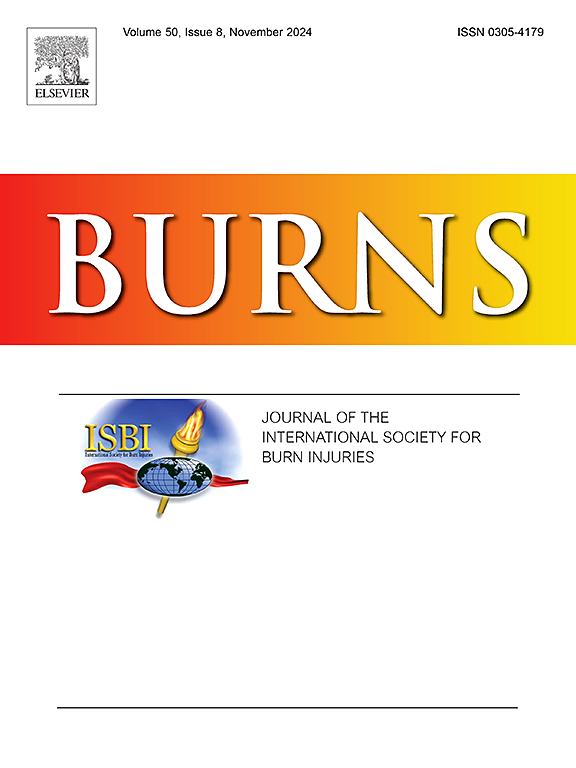Does the heat source affect the risk of wound infection in children with scalds?
IF 3.2
3区 医学
Q2 CRITICAL CARE MEDICINE
引用次数: 0
Abstract
Introduction
Scalds are the leading cause of burns in children younger than 5 years of age with most being related to food preparation and consumption. Hot substances causing scalds have different degrees of viscosity varying from low (liquid substances, such as water), to high (semi-solids or solids, such as oils or grease). It is still underknown whether heat substances with different viscosities are associated with varying risks of developing burn wound infections (BWI). The aim of this study was to investigate the association between heat sources of different viscosities and development of BWI within the first week after injury in children with scalds.
Method
Children 5 years and younger of age admitted at the Linköping Burn Center for new scalds between 2015 and 2020 were included. Data source for the study population was the Burn Unit Database. BWI was defined as fulfilment of at least two ABA criteria at the time of systemic antibiotic therapy (AB) initiation between day 2–7 following scald. Medical record review was undertaken to identify the heat source causing the scald, BWI criteria, and the use of AB. Legal guardians were contacted in cases in which information was missing. Logistic regression was used to analyse the association between heat source and development of BWI.
Result
The study population consisted of 271 children, median age was 1.5 years, 61 % were boys, median burn size was 3.5 % of the total body surface area (TBSA), 10 (4 %) had a full thickness burn. BWI were identified in 69 (26 %) of the children. Most scalds were caused by contact with hot liquids (n=184), followed by semisolids (n=52) and solids (n=35). The logistic regression model showed that the size of the burn (TBSA) was associated with BWI, while type of heating agent was not.
Conclusion
Our results indicate that the viscosity of the heat source does not affect the risk of wound infection in children with scalds; only the size of the area burned was an independent factor for BWI.
热源是否会影响烫伤儿童伤口感染的风险?
简介:烫伤是导致 5 岁以下儿童烧伤的主要原因,其中大部分与食物的准备和食用有关。导致烫伤的热物质具有不同的粘度,从低粘度(液态物质,如水)到高粘度(半固体或固体,如油或油脂)不等。不同粘度的热物质是否与发生烧伤创面感染(BWI)的不同风险有关,目前尚不清楚。本研究旨在调查不同粘度的热源与烫伤儿童受伤后一周内发生 BWI 的关联:研究对象包括林雪平烧伤中心在 2015 年至 2020 年期间收治的 5 岁及以下新发烫伤儿童。研究人群的数据来源于烧伤科数据库。烫伤后第 2-7 天开始接受全身抗生素治疗 (AB) 时至少符合两项 ABA 标准即为 BWI。对病历进行审查,以确定导致烫伤的热源、BWI 标准和 AB 的使用情况。如果信息缺失,则会联系法定监护人。采用逻辑回归分析热源与 BWI 发生之间的关联:研究对象包括 271 名儿童,年龄中位数为 1.5 岁,61% 为男孩,烧伤面积中位数为体表总面积的 3.5%,10 人(4%)为全厚烧伤。69名儿童(26%)被确认为BWI。大多数烫伤是由接触热液体引起的(184 人),其次是半固体(52 人)和固体(35 人)。逻辑回归模型显示,烧伤面积(TBSA)与BWI有关,而加热剂类型与BWI无关:我们的研究结果表明,热源的粘度不会影响烫伤儿童伤口感染的风险;只有烫伤面积的大小才是导致 BWI 的独立因素。
本文章由计算机程序翻译,如有差异,请以英文原文为准。
求助全文
约1分钟内获得全文
求助全文
来源期刊

Burns
医学-皮肤病学
CiteScore
4.50
自引率
18.50%
发文量
304
审稿时长
72 days
期刊介绍:
Burns aims to foster the exchange of information among all engaged in preventing and treating the effects of burns. The journal focuses on clinical, scientific and social aspects of these injuries and covers the prevention of the injury, the epidemiology of such injuries and all aspects of treatment including development of new techniques and technologies and verification of existing ones. Regular features include clinical and scientific papers, state of the art reviews and descriptions of burn-care in practice.
Topics covered by Burns include: the effects of smoke on man and animals, their tissues and cells; the responses to and treatment of patients and animals with chemical injuries to the skin; the biological and clinical effects of cold injuries; surgical techniques which are, or may be relevant to the treatment of burned patients during the acute or reconstructive phase following injury; well controlled laboratory studies of the effectiveness of anti-microbial agents on infection and new materials on scarring and healing; inflammatory responses to injury, effectiveness of related agents and other compounds used to modify the physiological and cellular responses to the injury; experimental studies of burns and the outcome of burn wound healing; regenerative medicine concerning the skin.
 求助内容:
求助内容: 应助结果提醒方式:
应助结果提醒方式:


